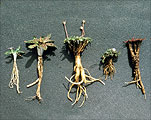 |
|
|
|
|
|
|
The alpine belt in the eastern front ranges of the Andes in NW-Argentina still receives 300-400 mm of precipitation per year. Rainfall is, however, extremely dependent on lee/luv effects. Within only one hundred meters' distance the climate can change from very wet to arid. In the humid (luv) part, the treeline is formed by Alnus at about 2800 m. In the dry interior (lee) we find a pre-puna type of dryland vegetation with 10 m tall cactus found up to 3000 m. |
|
1 - High Andean grassland at 4250 m dominated by Festuca orthophylla (Poaceae) (Azorella compacta (Apiaceae) in the foreground). |
|
|
2 - Azorella compacta (Apiaceae) (4200 m) |
3 - Azorella: Very solid cushions, hard as wood. |
4 - Azorella: Aromatic resin droplets at the surface. |
5 - Azorella: Extremely compact with slow growth. |
|
6 - High Andean grassland at 4250 m dominated by Festuca orthophylla. |
7 - Mimicking sand helps it hide from herbivores (one of the famous Andean Viola species.) |
8 - Mimicking granitic rock helps it hide from herbivores (one of the famous Andean Viola species.) |
|
9 - Small rosettes, closely attached to the ground to survive Guanaco grazing: Oenothera sp. (Onagraceae). |
10 - Perezia sp. (Asteraceae) |
11 - Caiophora nivalis (Loasaceae) (4250 m) |
12 - Massive roots resist frost heaving in winter: Perezia, Hypochoeris, Silene, Nototriche (Malvaceae), Calandrinia (Portulacaceae). |
|
13 - Tussock grass, cactus cushions (Tephrocactus af. boliviensis, Cactaceae), and herbaceous species form diverse mosaics at 4150 m. |
14 - Gentianella af. pulla (Gentianaceae) (4150 m) |
15 - Calceolaria sp. (Scrophulariaceae) (4200 m) |
16 - Calamagrostis (=Deyeuxia) hackelii (Poaceae) (4150 m) |
|
17 - Menonvillea virens (Brassicaceae) (Mt. Isabell, 4650 m) |
18 - Chaetanthera lycopodioides (Asteraceae) (Mt. Isabell, 4550 m) |
19 - Caiophora coronata (Loasaceae) (Real matadero, 4500 m) |
20 - A black flowering Valeriana sp. (Valerianaceae) (Mt. Isabell, 4600 m). |
29 August 2011 |
||
| |
||




















